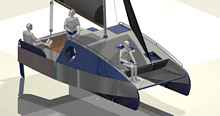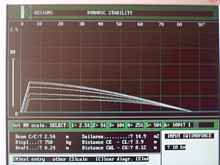|
The ECO 6 is clearly an enlarged version of our well known ECOnomy
cruiser. The ECOnomy cruiser is 5.5m long with a beam of 2.5m.
One of my clients in Brazil, who by the way has made these beautiful
renderings of the boat, wanted to use the Gunter rig and bigger
ECO. By looking at the possibilities new ideas could be realized
- bigger cockpit (for dimensions see lay out). The big surprise
came as I could find a space for a separate toilet room. A bit
unusual for such a small cat but the fairer sex will appreciate
it.
The jib stay is connected to a bridle, the compression load is
handled by the front beam which is made from a readily available
aluminium tube. The trampoline is also attached to the front beam.
Handling the anchor etc can be done from here, low and safe.
The front seats are a good place to be when underway in warm climates.
Good ventilation is ensured by a big front hatch and forward opening
windows in the front seat area.
Another addition are the seat extensions. Their function is
twofold, first to enhance stability and if folded up the they
are back rests. Other small differences: I moved the rudder link
to the back of the rudder housing. In this way the main sheet
can travel freely on its rail.
The Gunter rig is more or less the same as for my KD 650. The
main sail is now attached to a boom. Again drawings show not only
how to build the Gunter rig but also the boom. The jib is self
tending.
SPECIFICATIONS
L.O.A. 6.00 m
Beam 2.84 m
Beam c/c 2.24 m
Draught hull/board 0.22/1.00m
Weight 360 kg
Weight max. CWL 750 kg
Main 14.6 m2
Jib 4.6 m2
 |
Rendering ECO 6 |
Speed and stability
A bit more about this issue. Stability on a small family cruising
boat is paramount. I was happy that the regulations in
Brazil permit a trailing width of 2.85m and I was designing for
this maximum. The result is not bad. See dynamic stability below:
 |
The diagram shows the static stability. Which
is almost 1000 kilograms. The other curves show the stability
for 5, 10, 15, and 20 knots of wind. The calculations are
made with a safety making of 90%. Wind measurements have shown
that the wind fluctuations can be that big. Example: In a
force four wind you can have also force 7!! |
 |
Speed prediction. Because of the good stability
of the boat, the boat has also more speed. The prediction
shows the speed at differed wind speeds with a weight of the
boat of 550 kilograms (red line) and 750 kilograms (white
line). The speed prediction is without wave action. This means
the boat can be faster on flat water and will be slower in
big waves. |
 |
Layout |
Construction is like all my boats the time proven (ply)wood/glass,
Epoxy composite system. Easy to build also by a first time boat
builder. Time to build the boat and rig will be around 600 hours.
 |
The picture shows the internal structure of
the boat. |
The plans for the boat consists of 33 drawings. All technical
drawings are to scale 1 : 1. The DXF files can be used for CNC
cutting. But the simple shapes of for instance the bulkheads are
not worth the trouble. The description outlines the construction
of the boat and gives a detailed description with pictures of how
to build the hollow rudders and the daggerboard in a relative
easy way.
*****

|

